HONDA ACCORD HYBRID 2015 9.G Owners Manual
Manufacturer: HONDA, Model Year: 2015, Model line: ACCORD HYBRID, Model: HONDA ACCORD HYBRID 2015 9.GPages: 569
Page 541 of 569
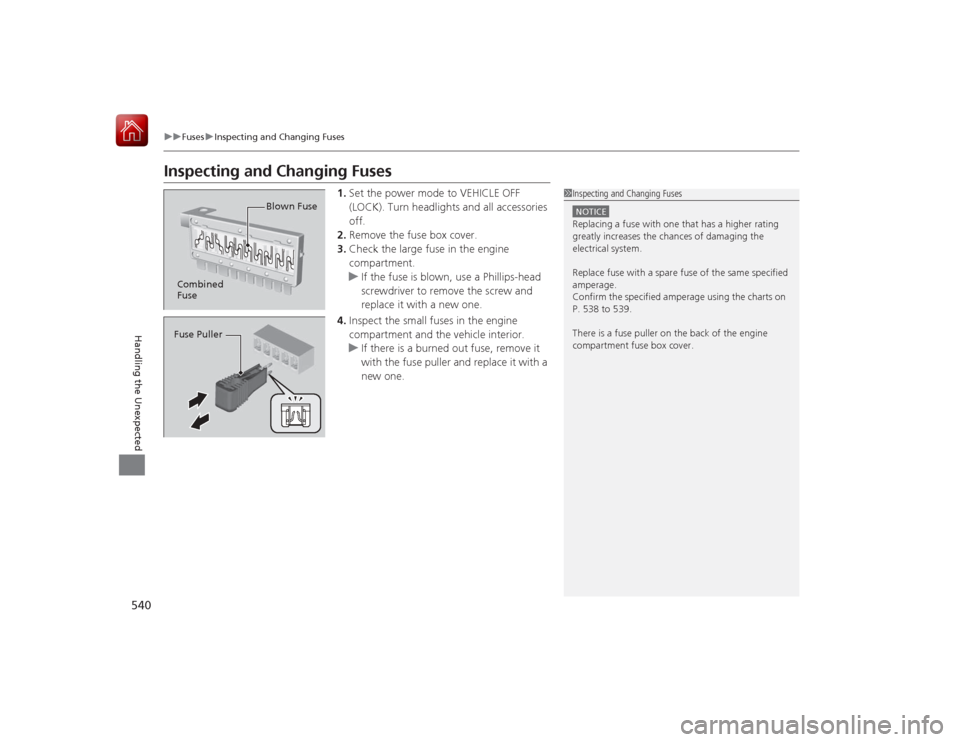
540
uuFuses uInspecting and Changing Fuses
Handling the Unexpected
Inspecting and Changing Fuses
1. Set the power mode to VEHICLE OFF
(LOCK). Turn headlights and all accessories
off.
2. Remove the fuse box cover.
3. Check the large fuse in the engine
compartment.
u If the fuse is blown, use a Phillips-head
screwdriver to remove the screw and
replace it with a new one.
4. Inspect the small fuses in the engine
compartment and the vehicle interior.
u If there is a burned out fuse, remove it
with the fuse puller and replace it with a
new one.
1Inspecting and Changing FusesNOTICEReplacing a fuse with one that has a higher rating
greatly increases the chances of damaging the
electrical system.
Replace fuse with a spare fuse of the same specified
amperage.
Confirm the specified amperage using the charts on
P. 538 to 539.
There is a fuse puller on the back of the engine
compartment fuse box cover.
Combined
Fuse Blown FuseFuse Puller
Page 542 of 569
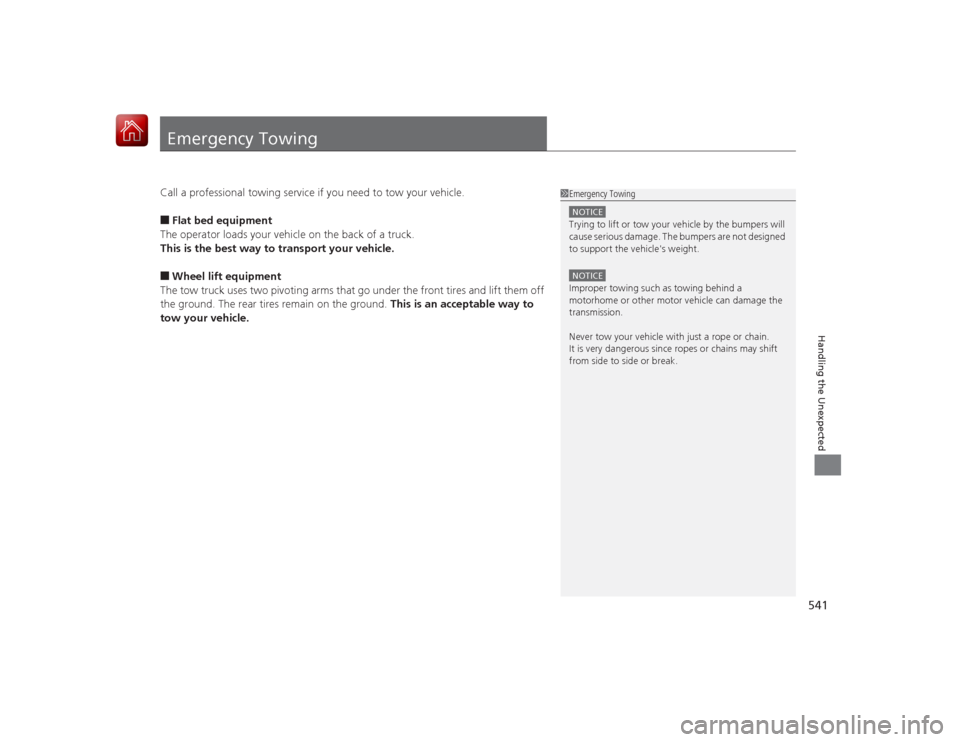
541Handling the Unexpected
Emergency TowingCall a professional towing service if you need to tow your vehicle.■Flat bed equipment
The operator loads your vehicle on the back of a truck.
This is the best way to transport your vehicle.■Wheel lift equipment
The tow truck uses two pivoting arms that go under the front tires and lift them off
the ground. The rear tires remain on the ground. This is an acceptable way to
tow your vehicle.
1 Emergency TowingNOTICETrying to lift or tow your vehicle by the bumpers will
cause serious damage. The bumpers are not designed
to support the vehicle's weight.NOTICEImproper towing such as towing behind a
motorhome or other motor vehicle can damage the
transmission.
Never tow your vehicle with just a rope or chain.
It is very dangerous since ropes or chains may shift
from side to side or break.
Page 543 of 569

542
Page 544 of 569
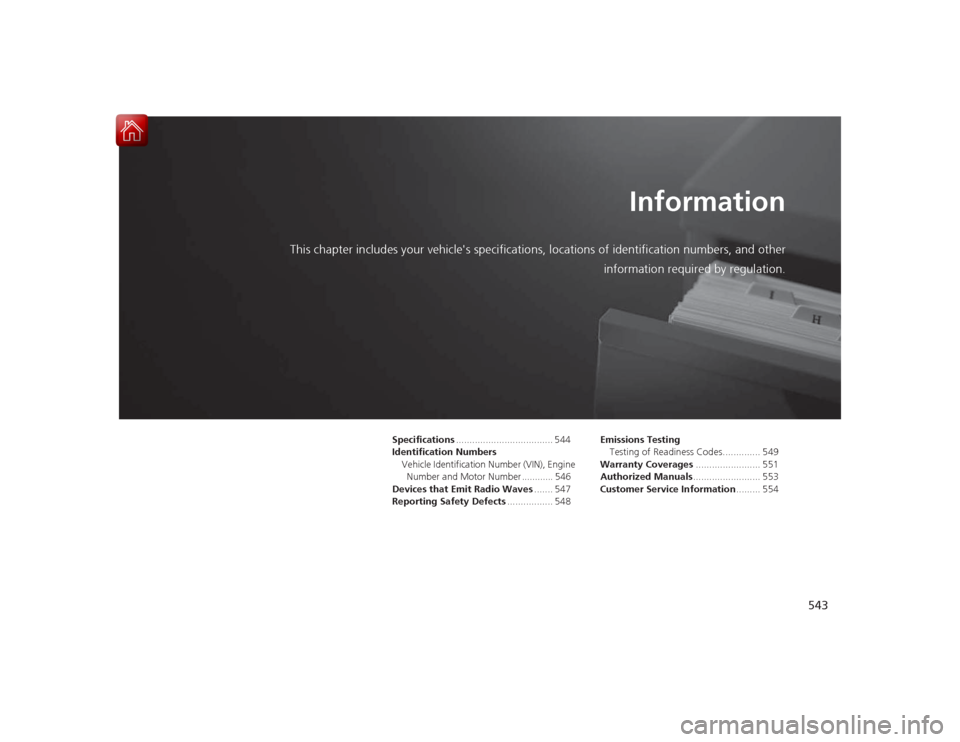
543
Information
This chapter includes your vehicle's specifications, locations of identification numbers, and other
information re quired by regulation.
Specifications .................................... 544
Identification Numbers Vehicle Identification Number (VIN), Engine Number and Motor Number ............ 546
Devices that Emit Radio Waves ....... 547
Reporting Safety Defects ................. 548Emissions Testing
Testing of Readiness Codes.............. 549
Warranty Coverages ........................ 551
Authorized Manuals ......................... 553
Customer Service Information ......... 554
Page 545 of 569
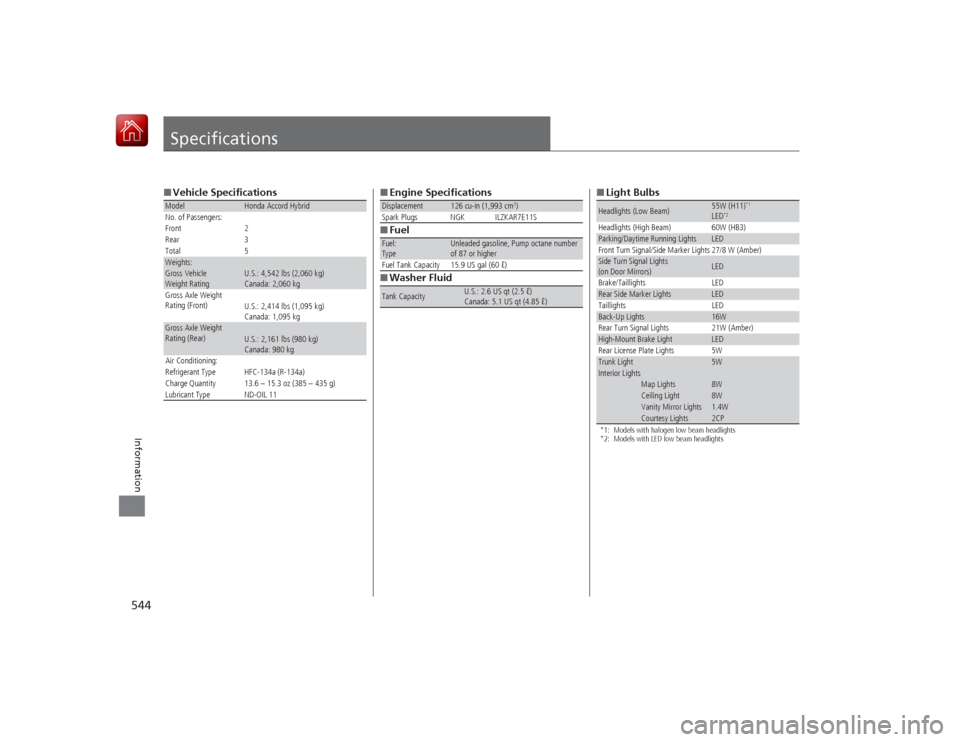
544Information
Specifications■Vehicle SpecificationsModel
Honda Accord Hybrid
No. of Passengers:
Front 2
Rear 3
Total 5
Weights:Gross Vehicle
Weight Rating
U.S.: 4,542 lbs (2,060 kg)
Canada: 2,060 kg
Gross Axle Weight
Rating (Front)
U.S.: 2,414 lbs (1,095 kg)
Canada: 1,095 kg
Gross Axle Weight
Rating (Rear)
U.S.: 2,161 lbs (980 kg)
Canada: 980 kg
Air Conditioning:
Refrigerant Type HFC-134a (R-134a)
Charge Quantity 13.6 – 15.3 oz (385 – 435 g)
Lubricant Type ND-OIL 11
■ Engine Specifications
■ Fuel
■ Washer FluidDisplacement
126 cu-in (1,993 cm
3)
Spark Plugs NGK ILZKAR7E11S
Fuel:
Type
Unleaded gasoline, Pump octane number
of 87 or higher
Fuel Tank Capacity 15.9 US gal (60 ℓ)
Tank Capacity
U.S.: 2.6 US qt (2.5 ℓ)
Canada: 5.1 US qt (4.85 ℓ)
■ Light Bulbs*1: Models with halogen low beam headlights
*2: Models with LED low beam headlightsHeadlights (Low Beam)
55W (H11)
*1
LED*2
Headlights (High Beam) 60W (HB3)Parking/Daytime Running Lights
LED
Front Turn Signal/Side Marker Lights 27/8 W (Amber)
Side Turn Signal Lights
(on Door Mirrors)
LED
Brake/Taillights LED
Rear Side Marker Lights
LED
Taillights LED
Back-Up Lights
16W
Rear Turn Signal Lights 21W (Amber)
High-Mount Brake Light
LED
Rear License Plate Lights 5W
Trunk Light
5W
Interior Lights
Map Lights
8W
Ceiling Light
8W
Vanity Mirror Lights
1.4W
Courtesy Lights
2CP
Page 546 of 569
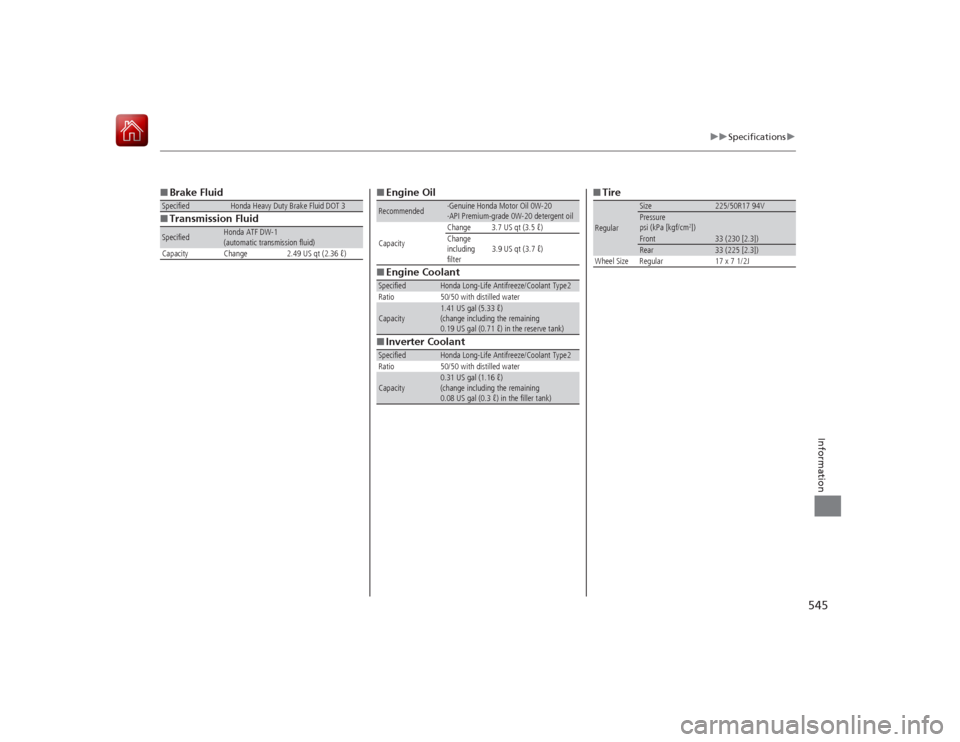
545
uuSpecifications u
Information
■Brake Fluid
■ Transmission FluidSpecified
Honda Heavy Duty Brake Fluid DOT 3
Specified
Honda ATF DW-1
(automatic transmission fluid)
Capacity Change 2.49 US qt (2.36 ℓ)
■ Engine Oil
■ Engine Coolant
■ Inverter CoolantRecommended
·Genuine Honda Motor Oil 0W-20
·API Premium-grade 0W-20 detergent oil
Capacity Change 3.7 US qt (3.5 ℓ)
Change
including
filter
3.9 US qt (3.7 ℓ)
Specified
Honda Long-Life Antifreeze/Coolant Type2
Ratio 50/50 with distilled water
Capacity
1.41 US gal (5.33 ℓ)
(change including the remaining
0.19 US gal (0.71 ℓ) in the reserve tank)
Specified
Honda Long-Life Antifreeze/Coolant Type2
Ratio 50/50 with distilled water
Capacity
0.31 US gal (1.16 ℓ)
(change including the remaining
0.08 US gal (0.3 ℓ) in the filler tank)
■ TireRegular
Size
225/50R17 94V
Pressure
psi (kPa [kgf/cm
2])
Front
33 (230 [2.3])
Rear
33 (225 [2.3])
Wheel Size Regular 17 x 7 1/2J
Page 547 of 569
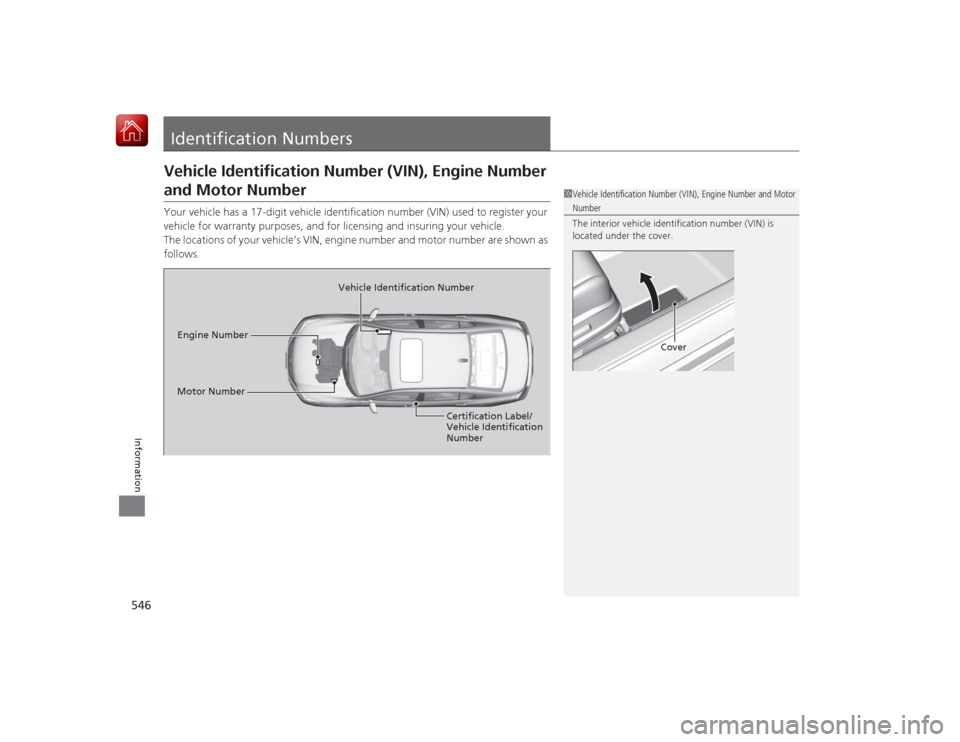
546Information
Identification NumbersVehicle Identification Number (VIN), Engine Number and Motor NumberYour vehicle has a 17-digit vehicle identification number (VIN) used to register your
vehicle for warranty purposes, and for licensing and insuring your vehicle.
The locations of your vehicle’s VIN, engine number and motor number are shown as
follows.
1 Vehicle Identification Number (VIN), Engine Number and Motor Number
The interior vehicle iden tification number (VIN) is
located under the cover.
Cover
Vehicle Identification Number
Engine Number
Certification Label/
Vehicle Identification
Number
Motor Number
Page 548 of 569
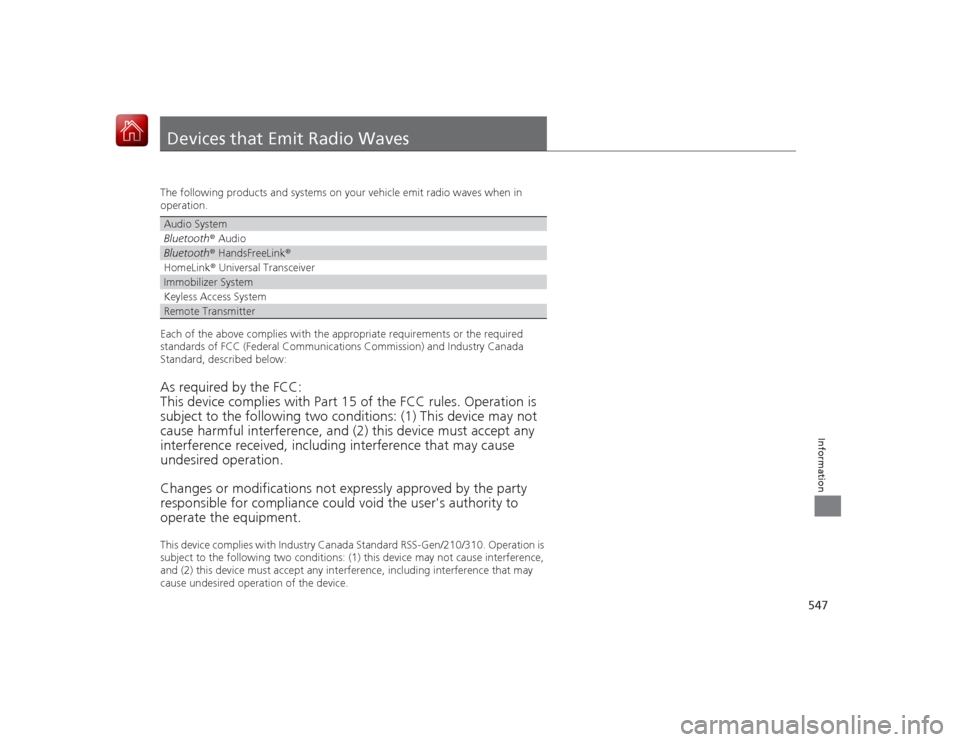
547Information
Devices that Emit Radio WavesThe following products and systems on your vehicle emit radio waves when in
operation.
Each of the above complies with the appropriate requirements or the required
standards of FCC (Federal Communications Commission) and Industry Canada
Standard, described below:As required by the FCC:
This device complies with Part 15 of the FCC rules. Operation is
subject to the following two conditions: (1) This device may not
cause harmful interference, and (2) this device must accept any
interference received, i ncluding interference that may cause
undesired operation.
Changes or mo difications not expressly approved by the party
responsible for compliance could void the user's authority to
operate the equipment.This device complies with Industry Canada Standard RSS-Gen/210/310. Operation is
subject to the following two conditions: (1) this de vice may not cause interference,
and (2) this device must accept any interference, including interference that may
cause undesired operation of the device.Audio SystemBluetooth ® AudioBluetooth® HandsFreeLink ®HomeLink® Universal TransceiverImmobilizer SystemKeyless Access SystemRemote Transmitter
Page 549 of 569
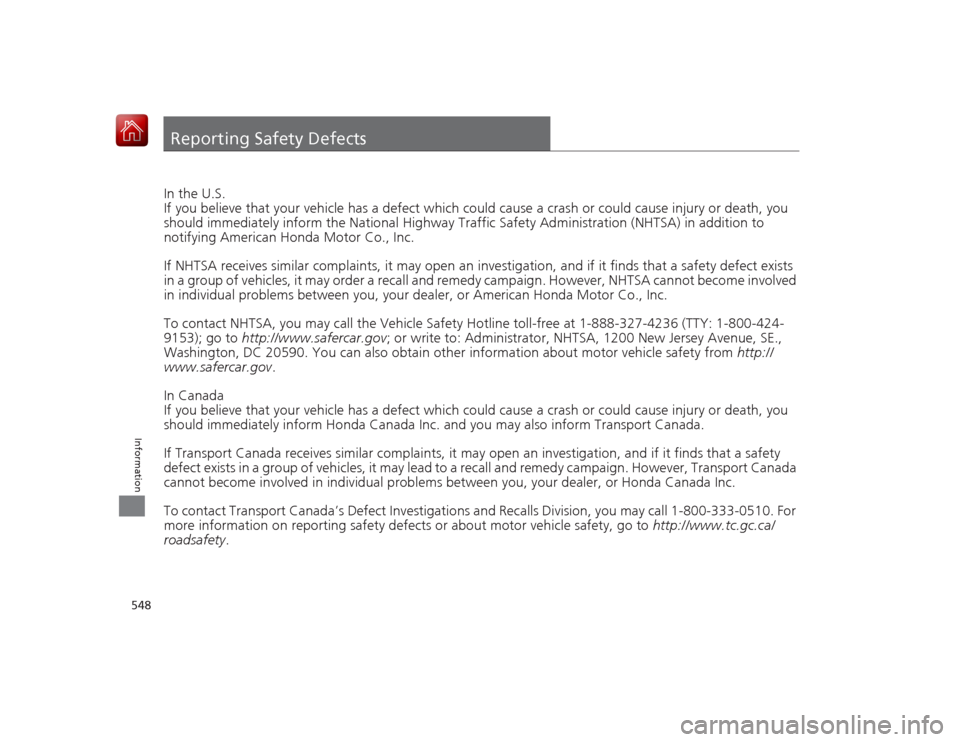
548Information
Reporting Safety DefectsIn the U.S.
If you believe that your vehicle has a defect which could cause a crash \
or could cause injury or death, you
should immediately inform the National Highway Traffic Safety Administration (NHTSA) in addition to
notifying American Honda Motor Co., Inc.
If NHTSA receives similar complaints, it ma y open an investigation, and if it finds that a safety defect exists
in a group of vehicles, it may or der a recall and remedy campaign. However, NHTSA cannot become involved
in individual problems between you, your dealer, or American Honda Motor Co., Inc.
To contact NHTSA, you may call the Vehicle Safety Hotline toll-free at 1-888-327-4236 (TTY: 1-800-424-
9153); go to http://www.safercar.gov ; or write to: Administrator, NHTSA, 1200 New Jersey Avenue, SE.,
Washington, DC 20590. You can also obtain other information about motor vehicle safety from http://
www.safercar.gov .
In Canada
If you believe that your vehicle has a defect which could cause a crash \
or could cause injury or death, you
should immediately inform Honda Canada Inc. and you may also inform Transport Canada.
If Transport Canada receives simi lar complaints, it may open an investigation, and if it finds that a safety
defect exists in a group of vehicles, it may lead to a reca ll and remedy campaign. However, Transport Canada
cannot become involved in individ ual problems between you, your dealer, or Honda Canada Inc.
To contact Transport Canada’s Defect Investigations and Recalls Division, you may call 1-800-333-0510. For
more information on reporting safety defects or about motor vehicle safety, go to http://www.tc.gc.ca/
roadsafety .
Page 550 of 569
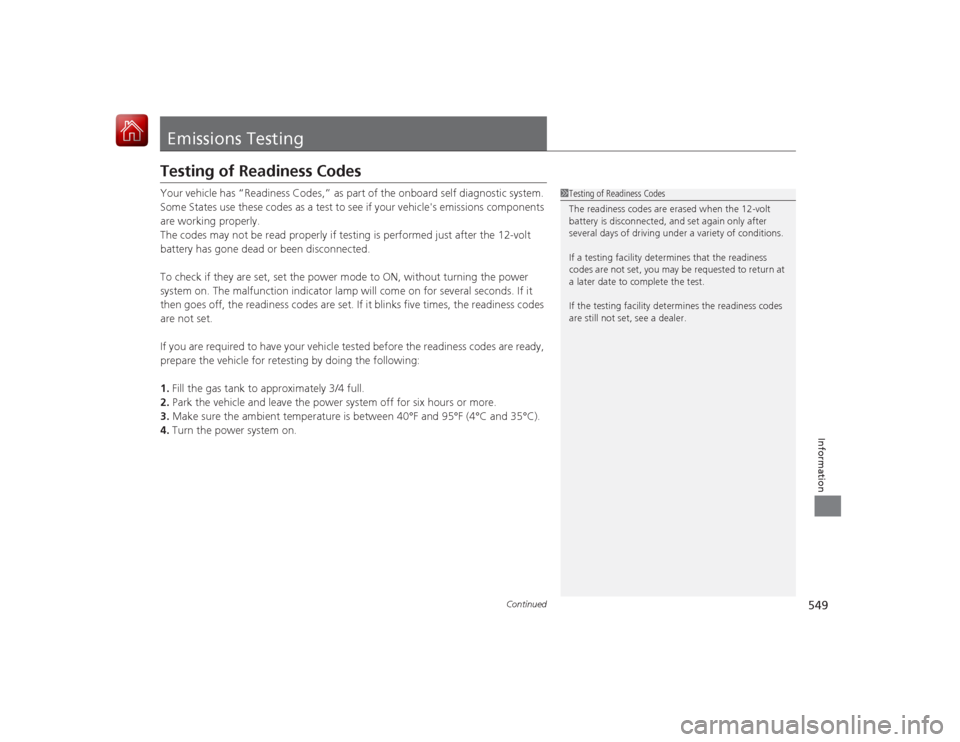
549
Continued
Information
Emissions TestingTesting of Readiness CodesYour vehicle has “Readiness Codes,” as part of the onboard self diagnostic system.
Some States use these codes as a test to see if your vehicle's emissions components
are working properly.
The codes may not be read properly if testing is performed just after the 12-volt
battery has gone dead or been disconnected.
To check if they are set, set the power mode to ON, without turning the power
system on. The malfunction indicator lamp will come on for several seconds. If it
then goes off, the readiness codes are set. If it blinks five times, the readiness codes
are not set.
If you are required to have your vehicle tested before the readiness codes are ready,
prepare the vehicle for retesting by doing the following:
1. Fill the gas tank to approximately 3/4 full.
2. Park the vehicle and leave the power system off for six hours or more.
3. Make sure the ambient temperature is between 40°F and 95°F (4°C and 35°C).
4. Turn the power system on.
1Testing of Readiness Codes
The readiness codes are erased when the 12-volt
battery is disconnected, and set again only after
several days of driving under a variety of conditions.
If a testing facility dete rmines that the readiness
codes are not set, you may be requested to return at
a later date to complete the test.
If the testing faci lity determines the readiness codes
are still not set, see a dealer.